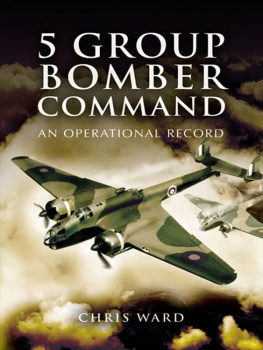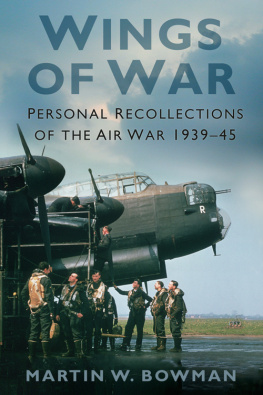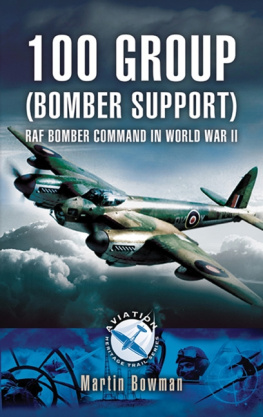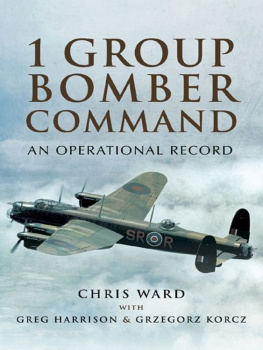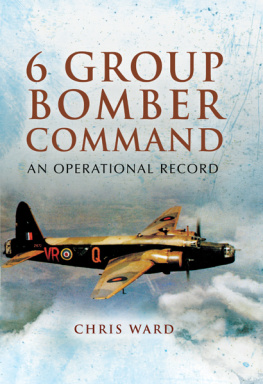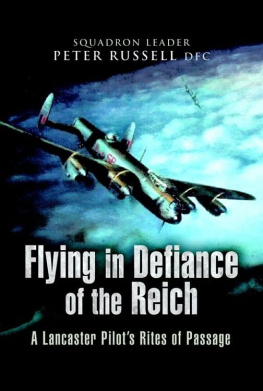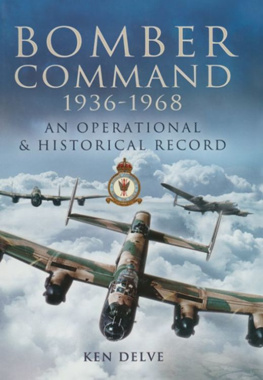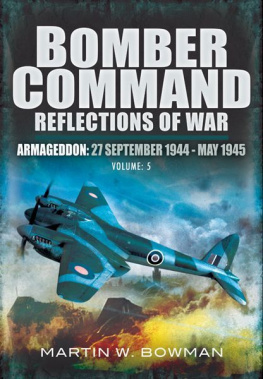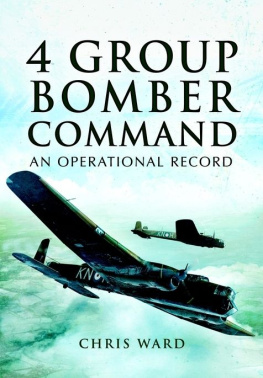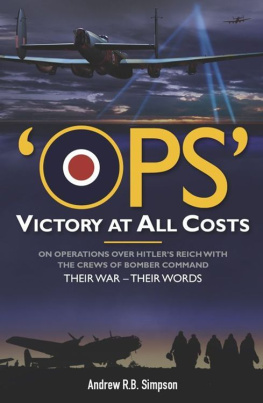
First published in Great Britain in 2007 by
Pen and Sword Aviation
an imprint of
Pen & Sword Books Ltd
47 Church Street
Barnsley
South Yorkshire
S70 2AS
Copyright Chris Ward, 2008
ISBN 978-14415579
eISBN 9781844687374
The right of Chris Wards to be identified as Authors of this Work has been asserted by him in accordance with the Copyright, Designs and Patents Act 1988.
A CIP catalogue record for this book is
available from the British Library
All rights reserved. No part of this book may be reproduced or transmitted in any form or by any means, electronic or mechanical including photocopying, recording or by any information storage and retrieval system, without permission from the Publisher in writing.
Typeset in 10/12 Times New Roman by
Concept, Huddersfield, West Yorkshire
Printed and bound in England by
Biddles Ltd
Pen & Sword Books Ltd incorporates the Imprints of Pen & Sword Aviation, Pen
& Sword Maritime, Pen & Sword Military, Wharncliffe Local History,
Pen & Sword Select, Pen & Sword Military Classics, Leo Cooper.
For a complete list of Pen & Sword titles please contact
PEN & SWORD BOOKS LIMITED
47 Church Street, Barnsley, South Yorkshire, S70 2AS, England
E-mail: enquiries@pen-and-sword.co.uk
Website: www.pen-and-sword.co.uk
Acknowledgements
Most of the figures used in the statistics section of this work, have been drawn from The Bomber Command War Diaries by Martin Middlebrook and Chris Everitt, and I am indebted to Martin Middlebrook for allowing me to use them.
Generous assistance in the compiling of lists of commanding officers has been provided by Anna McIlwaine at the RAF Museum at Hendon, until her retirement in 1998. Also of considerable help in this regard, and with details of awards, is Clive Richards at the Air Historical Branch of the Air Ministry, to whom I am greatly indebted.
My good friend, author Martyn Ford-Jones, had allowed me to draw extensively from his research material, particularly in respect of losses during 1945. I am also extremely grateful to my friend Steve Smith, an historian of 3 Group in general, and 218 and 623 Squadrons in particular, for conducting research on my behalf whenever he is at the PRO.
A special mention is due to Chris Salter of Midland Counties Publications, without whose generous assistance and encouragement at the outset, I would not have been able to compile a complete list of all operational aircraft on charge with Bomber Command squadrons during the war period, a list, incidentally, which comprises some 28,000 entries.
Contents
General Notes
This profile is a reference work on the activities of the Group and the squadrons serving with it in an operational capacity at some time during the Second World War. Bomber Command operated exclusively from stations in the UK, and used overseas bases purely for shuttle operations, or as advanced staging posts for specific purposes. For this reason, periods spent on detachment, or permanent postings to overseas Commands do not fall within the scope of this work.
This profile is not intended to serve as a comprehensive history of the Group or squadrons, but to provide as much information as possible in a non-anecdotal form. The brief history narrative is basically an account of Bomber Commands war, with the Groups involvement interwoven into it. The publications listed on are not only recommended reading, but represent the best available sources of information for serious students of the subject. The operational record is based almost entirely on the figures provided in The Bomber Command War Diaries by Martin Middlebrook and Chris Everitt, and I am indebted to Martin Middlebrook for allowing me to use them.
An aircraft is included in chapter two if; (a) it spent time on squadron charge, no matter how briefly, and irrespectively of whether or not it operated and (b) the type was used operationally by the squadron. Information is restricted in most cases to where from and where to, unless it completed its service with the squadron, in which case, some detail of its demise appears. Aircraft which failed to return have the date and target recorded. Where no information follows the serial number of a type still in use when the squadron departed Bomber Command, or at wars end, it can be assumed that the aircraft was still on squadron strength. However, where there is a blank space following the serial number of a type which has been withdrawn from service with Bomber Command, it signifies that I dont know its ultimate fate. An absence of information does not imply that the aircraft flew no operations during its time with the squadron.
C HAPTER O NE
A Narrative History
Organisation
5 Group was formed from 3 Group on the 1 September 1937. Administration remained at Mildenhall until the 2 October, when it was transferred to St Vincents on the outskirts of Grantham. The seven founder squadrons were 44, 50, 61, 110, 113, 144 and 211. No. 44 Squadron was equipped with the Blenheim Mk I, while the remainder operated Hind and Audax biplanes. Nos 44, 50 and 110 squadrons were based at Waddington, 61 and 144 at Hemswell, while 113 and 211 squadrons resided at Grantham. On the 14 March 1938 Scampton was transferred to 5 Group, along with its resident squadrons, 49 and 83. In May 110, 113 and 211 Squadrons were posted to the Middle East. Thornaby was transferred to the Group on the 1 September, bringing 106 and 185 Squadrons within the fold. No. 49 Squadron became the first RAF unit to receive the new Hampden on the 20 September. By the beginning of June 1939 the entire Group was operating the type. For ease of servicing and training it was the sensible policy at this time for each Group to operate one aircraft type. While 5 Group was the lone operator of the Hampden, 1 Group flew the Fairey Battle, 2 Group the Bristol Blenheim, 3 Group the Wellington and 4 Group the Whitley. Air Commodore Callaway was Air-Officer-Commanding 5 Group as war began.
1939. Lessons to learn
At the outbreak of war 5 Group possessed six operational squadrons, 44 and 50 at Waddington, commanded respectively by W/C Bootham and W/C Young, 49 and 83 at Scampton under the commands of W/C Chick and W/C Jordan, and 61 and 144 at Hemswell, led by W/C Brill and W/C Cunningham. W/C Bootham was appointed on the day war broke out, and it was he who had won the Schneider Trophy outright for Britain in the famed Supermarine S6B in 1931. No. 106 Squadron, which would be employed as the Groups training unit for the first year of the war, had just been transferred to Cottesmore in Rutland under the command of S/L Sheen, but both he and the squadron would soon be on the move again. On the first day of hostilities nine Hampdens from 44 Squadron and three and six respectively drawn from 49 and 83 Squadrons, conducted a daylight shipping search over the North Sea. Among the 83 Squadron contingent was a young Guy Gibson, whose exploits later in the war would earn him celebrity status. Having not departed their stations until around 18.00 hours, it was already dark before the Schillig Roads area was reached, and this first operation by the Group was concluded without result, setting the tenor for the rest of the year. AVM Arthur Harris was appointed as the Groups AOC on the 11 September, a post he would retain for more than a year.
There were to be very few operational sorties by the Groups Hampdens during the remainder of 1939, and, indeed, until well into the following year. There was, in fact, a gap of twenty-five days between the Groups first operation and its second, which involved twelve aircraft on the 26th. The Groups third operation, another shipping sweep to the Heligoland Bight area, was mounted on the 29th by twelve Hampdens of 144 Squadron. Two formations of six aircraft led by W/C Cunningham and S/L Lindsay, departed Hemswell to fly independently to the target area timed to arrive at around 10.00 hours. This was the time that previous reconnaissance flights had shown elements of the Kriegsmarine to be at sea, on their way home to base after exercising under cover of darkness. One member of W/C Cunninghams formation soon turned back with engine trouble while the remainder pressed on. S/L Lindsays formation sighted and attacked two enemy destroyers without scoring any hits, but W/C Cunningham ran into a hornets nest of fighters. One by one the five Hampdens were hacked down into the sea, and sixteen of the twenty crewmen lost their lives, including W/C Cunningham. The disaster afflicting 144 Squadron should have caused alarm bells to ring concerning the ability of self-defending bombers to always get through in daylight. Rather than allowing the evidence to highlight the flaws in this pre-war theory, however, the policy-makers at Bomber Command chose to ignore the obvious and blame the crews for poor formation flying. This stubbornness would cost further lives before common sense and reason prevailed. On the 26 September, 61 Squadron had appointed W/C De Crespigny as its new commanding officer. On the 1 October the popular and well-respected New Zealander, W/C Jordan, was posted in from 83 Squadron to take command of 144 Squadron, and W/C Snaith stepped into his shoes at 83, returning to a post he had held for two years prior to the appointment of W/C Jordan. The next foray by the Group involved just three Hampdens on the 20 November, all of which returned without incident.
Next page
